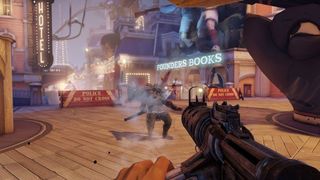BioShock Infinite system requirements released, interview with Irrational about PC features

Grab a tiny knife and carve off 20 GB for BioShock Infinite. Irrational Games has put forth a wish list of PC parts for its impending single-player shooter in required and recommended forms, as is the tradition (interestingly, the “Recommended” spec demands 30 GB of space).
Pop inside for the run-down, and for bonus details about BioShock Infinite's benchmark tool courtesy of the game's technical director.
BioShock Infinite system requirements:
MINIMUM
- OS: Windows Vista Service Pack 2 32-bit
- Processor: Intel Core 2 DUO 2.4 GHz / AMD Athlon X2 2.7 GHZ
- Memory: 2 GB
- Hard Drive: 20 GB free
- Video Card: DirectX10 Compatible ATI Radeon 3870 / NVIDIA 8800 GT / Intel HD 3000 Integrated Graphics
- Video Card Memory: 512 MB
- Sound Card: DirectX Compatible
RECOMMENDED
- OS: Windows 7 Service Pack 1 64-bit
- Processor: Quad Core Processor
- Memory: 4 GB
- Hard Drive: 30 GB free
- Video Card: DirectX11 Compatible, ATI Radeon 6950 / NVIDIA GeForce GTX 560
- Video Card Memory: 1024 MB
- Sound Card: DirectX Compatible
For the many-monitored, Irrational's release also mentions that Infinite will support AMD EyeFinity, NVIDIA Surround, and Matrox TripleHead2Go. Hooray!

PCG: It's rare for developers to take the time to build a benchmark tool these days. Why do it with Infinite?
Christopher Kline, Technical Director: Let me put it this way. The Ford Motor Company makes cars for everyone. That's hard work—a big commitment. They have to build a whole range of cars to support all different budgets and practical purposes. But they also make the $150,000 Ford GT. This car is completely unaffordable and has no practical purpose except, perhaps, to be gawked over. Sure, most people would stop and take a look if they saw a GT on the street. But some people—the enthusiasts—they want it. They need it. The benchmark mode is for those kinds of PC gamers.
The biggest gaming news, reviews and hardware deals
Keep up to date with the most important stories and the best deals, as picked by the PC Gamer team.
For BioShock Infinite, Irrational Games made a commitment to making the best PC version we could. This meant building a product that could run well on a wide range of hardware, but also had value for the high-end hardware enthusiasts. For many people, the benchmark mode will be a way of testing out the impact of various graphics options, finding a good settings level for their system, testing out new hardware, or maybe just a fun curiosity. But for the enthusiasts, this tool lets them gather data in a controlled way so they can analyze the results and tweak their rig to its fullest potential. And maybe even brag a little.
Does this mean Irrational is trying to cater to a niche PC enthusiast crowd and make special features for the PC gamer? Well, guilty.
What are the features of the benchmark itself?
Kline: The benchmark tool does a controlled fly-through of several actual scenes from a level in BioShock Infinite. When you first launch it, you get to choose which settings you'd like to test, such as resolution, aspect ratio, and graphics quality level. These options include all the presets available to you in game, or you can choose to use your last active in-game settings in the event that you're tweaking our extensive list of custom graphics options.
Along the way the benchmark mode captures minimum, maximum, and average framerate over 500 millisecond intervals, along with the name of the scene being captured. When the benchmark ends, it writes out a small spreadsheet in .csv format that you can analyze or graph in any way you want. The spreadsheet also contains the value of all relevant settings that were in effect at the time of the benchmark, so people can compare apples to apples.
It's also fully automatable, for people who want to run a whole suite of tests automatically overnight through custom scripting.
That's great news for us and our sister publication MaxPC , actually. We need new game benchmarks. Let's talk DX11, though—which features does Infinite support?
Kline: We have some great DX11-only features that I think gamers will really appreciate. First, there's Contact Hardening Shadows that take advantage of DX11's Shader Model 5. These look much more realistic than the shadows available on DX10 hardware. Next up, AMD's High Definition Ambient Occlusion (HDAO) takes advantage of DirectCompute to add extremely high-quality micro-detail to indirect shadowing in the scene, which greatly increases visual fidelity. We also provide an alternate post-processing mode that uses Compute Shaders to implement Diffusion Depth of Field, creating a softer and more photographic look to portions of the scene that aren't in focus. And finally, our implementation of FXAA has a special version optimized specifically for SM5.

How would you describe the graphical difference between the original BioShock and Infinite? At first glance, what's noticeably different?
Kline: Do you remember all the gorgeous sunset views and brightly-lit outdoor scenes in the original BioShock? No? Neither do I.
Right from the beginning our rendering team was faced with the problem of supporting BioShock Infinite's much wider range of environments. To do this they had to implement a new renderer with entirely different approaches to lighting, shadowing, and level of detail. The resulting technology is a powerhouse that can handle not only the hugely expansive and brightly lit outdoor areas of Columbia, a floating city where everything is constantly moving, but also dark and creepy interiors similar to those in the original BioShock. Supporting these extremes well, and increasing visual quality at the same time, was an enormous challenge for the teams led by both Steve Anichini, our principal graphics engineer, and Spencer Luebbert, our Technical Artist. The result of all that hard work is the amazing world of BioShock Infinite—a place that BioShock veterans will instantly notice is both wondrously different and yet somehow... strangely familiar.
Where did the decision to prioritize PC-specific features come from in the case of Infinite? Who led that initiative?
Kline: After the original BioShock shipped, there was a bit of regret that we didn't have the time to do everything we wanted to for the PC version. We were punching a bit above our weight on that title, and in the end it was a matter of time and resources, not a lack of good intentions.
This time around, for BioShock Infinite, we were determined to do it right. A long time ago we built up a special team responsible for both identifying what is important to PC gamers, and also for making sure those features were implemented to a high quality standard. The company made sure we had the resources we needed to get the job done, whether that was to buying more triple-monitor AMD EyeFinity setups for testing, flying in Intel engineers from Poland to help improve performance on their newer laptop chipsets, or hiring additional staff so we didn't have to cut PC-specific features in order to ship on time.
While I may have been in charge of coordinating that team, and occasionally making sure the PC had an equal voice at the table, it was the entire team's suggestions, hard work and enthusiasm for PC gaming that made BioShock Infinite a title designed to appeal to PC gamers.

Evan's a hardcore FPS enthusiast who joined PC Gamer in 2008. After an era spent publishing reviews, news, and cover features, he now oversees editorial operations for PC Gamer worldwide, including setting policy, training, and editing stories written by the wider team. His most-played FPSes are CS:GO, Team Fortress 2, Team Fortress Classic, Rainbow Six Siege, and Arma 2. His first multiplayer FPS was Quake 2, played on serial LAN in his uncle's basement, the ideal conditions for instilling a lifelong fondness for fragging. Evan also leads production of the PC Gaming Show, the annual E3 showcase event dedicated to PC gaming.
Most Popular







